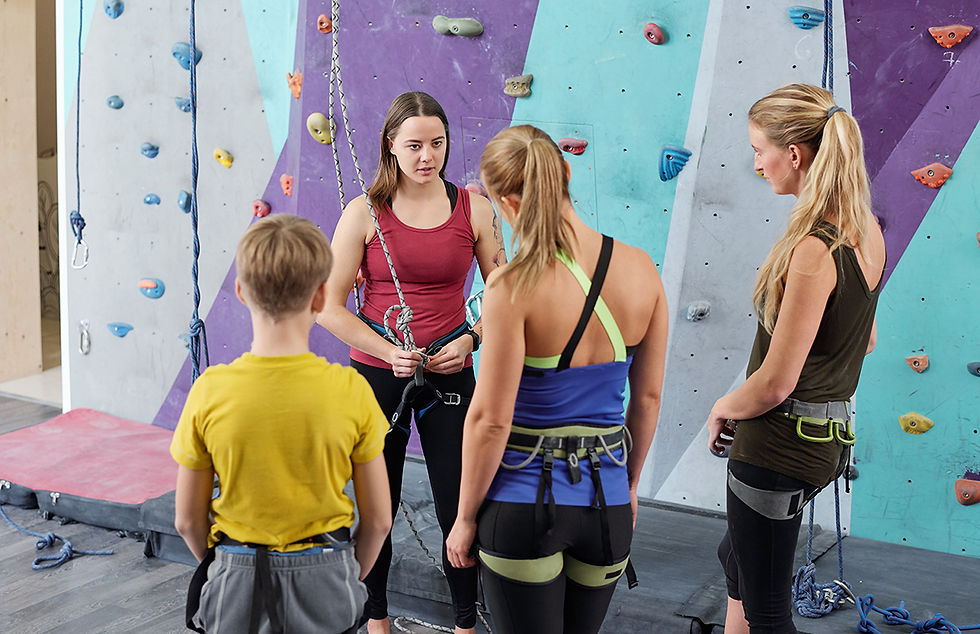What to Wear for Your First Time Rock Climbing
- Staff
- Sep 25
- 4 min read
Updated: Nov 7
Rock climbing can range from a fun hobby to a serious sport, but whether someone is a world-class climber or a pure hobbyist, they all have the same experience of stepping into the gym for the very first time. As the famous Deion Sanders said, “Look good, feel good, play good.” So, be sure to know what to wear on your inaugural trip to the rock climbing gym to ensure a safe and successful experience.

Clothing: Be Safe, Be Cool, Be Cute
Think about dressing for the sport of climbing as though you are dressing for a rousing game of Twister. Your clothes should be comfortable and should easily move with your body. If you aren’t relaxed and confident, you won’t want to get on the wall. It’s easy enough to opt for athletic wear like stretchy leggings or fitted joggers, which allow for mobility in your hips and knees.
However, thicker pants like jeans can also be seen in the climbing gym, as they protect climbers from abrasions caused by knee bars or falling on sloped geometry.
On your first trip, regular athletic bottoms will likely suffice. Your top should be well-fitted, with its most important quality being that it doesn’t hinder your range of motion in your shoulders.
Whether you are bouldering or top-roping, it is best to avoid overly baggy clothing. Baggy clothes can catch on juggy holds, creating a safety hazard or simply becoming a nuisance while you climb.
Bouldering - be prepared to fall
Bouldering differs from top roping because it involves much shorter, powerful moves and guarantees significantly more falls. Not to worry, the bouldering pads are great at absorbing the impact of a fall.
Every gym will have a safety orientation video that teaches you how to fall correctly and safely. Still, what you choose to wear can impact your comfort while bouldering, and ultimately, your comfort while falling.
Avoid clothing that has hard attachments, such as large buttons, zippers, or buckles. If your bottoms have pockets, be mindful not to climb with anything in your pockets. Not only is falling onto something like a cell phone in your back pocket a hazard to you, but if it falls out while you are on the wall, it can be a hazard to those on the mats below you as well.
Important Safety Tip: Never wear a harness while bouldering. A harness has metal components that can injure you on impact, as well as multiple loops that can easily get snagged on holds. A harness that catches on a hold can cause you to fall awkwardly and unnaturally, or prevent you from falling safely to the pads at all. These risks and dangers are significant, even if you fall from a short height.
Top Rope & Autobelay - being aware of moving parts

Whether you are clipping into an autobelay or you have a belay partner giving you a catch, you’ll need to wear a harness while doing any vertical wall climbing. Pants or leggings are often a popular choice, but they must fit tightly enough to prevent bunching around the waist and leg loops of the harness.
High-waisted leggings can provide extra protection against friction from the waist belt. A fitted or tucked-in top can help prevent friction or catching between you, your harness, and your rope.
Your harness waist belt should fit tight, with room for no more than two fingers to slip in, and should sit above your hips. Your leg loops should also follow the two-finger rule, but not be so tight or short that they ride uncomfortably into the groin area or pinch the skin.
.
Time to Accessorize, by de-accessorizing
A common item that new climbers frequently overlook but can cause a rather gruesome injury is finger accessories, such as rings. Forgetting to remove rings and other hand jewelry before climbing on the wall can lead to minor to major complications in the event of a finger injury or an unexpected fall. Finger injuries are common in climbing, and an injured finger often swells and becomes inflamed. A ring can easily get stuck on an injured finger, causing circulation issues and requiring the ring to be cut off.
In rare cases, a ring can get caught on a hold or snagged by the texture of a hold or the wall, resulting in an injury referred to as “degloving.” This is when skin on the finger can be ripped by rings, causing severe damage to the climber’s hand.
If you want to wear a ring, the best option is to choose a silicone ring. Silicone rings easily stretch and move with you as a climber and do not pose a degloving risk.
Socks or No Socks?
Ah, the great debate amongst the climbing community: is wearing socks with climbing shoes a cardinal sin or a comfortable choice? While this topic is polarizing, the answer ultimately comes down to personal preference. Some climbers swear by going barefoot inside their shoes for better control and feel. Others prefer thin socks to wick away smelly sweat and help break in a shoe. Your first trip to the climbing gym will likely include rental shoes, so you may want to wear socks to feel more comfortable and hygienic. Either way, whatever makes you feel confident and relaxed, and allows you to focus on climbing is the right choice!
Dressing appropriately for rock climbing ensures that you can move freely, stay safe, and thoroughly enjoy your first experience. After all, you only get a first time once! Prioritize comfort and safety by avoiding loose-fitting clothing and leaving jewelry at home. Let us know your favorite fit to wear to the gym in the comments below!






Comments